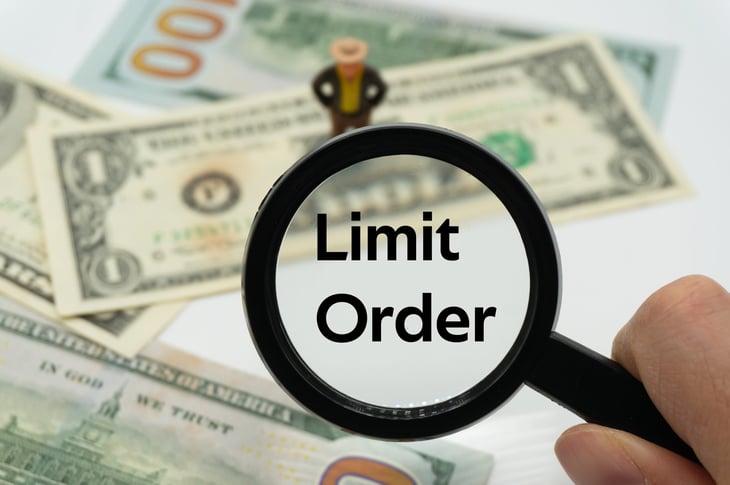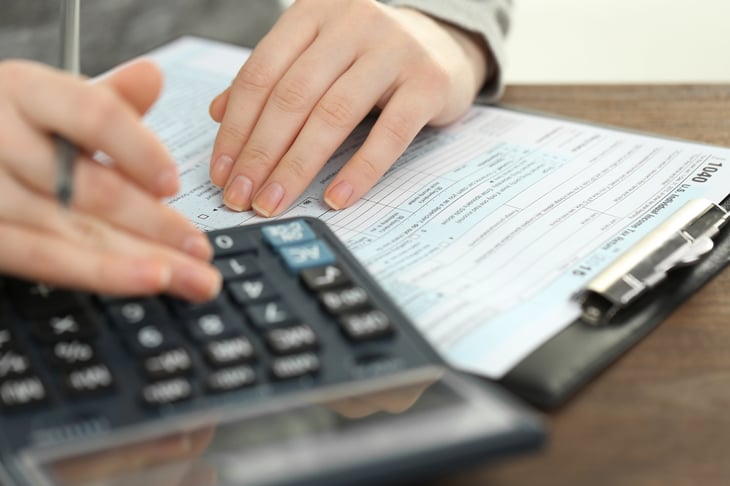
G-Inventory Studio / Shutterstock.com
Editor’s Notice: This story initially appeared on The Penny Hoarder.
There’s rather a lot to contemplate when promoting stocks, together with your tax invoice.
Folks sell stocks for quite a few causes. However when you make a revenue from the sale, you usually have to report it once you file your taxes the next yr.
(Totally different guidelines apply when promoting shares inside a retirement account.)
Earlier than you click on that commerce button, be sure to perceive what occurs once you sell a inventory.
This is every part it’s essential know.
Know when to sell a inventory
 Phonlamai Picture / Shutterstock.com
Phonlamai Picture / Shutterstock.com
There is no such thing as a “good” time to sell a inventory. One of the best time to sell is dependent upon your private funding technique, danger tolerance and time horizon.
Inventory costs rise and fall, so that you should not sell inventory simply because it is skilled a brief drop. However, you do not need to maintain onto falling stocks which have little hope of a restoration.
For many traders, holding stocks for the long run is the most effective technique. Keep away from impulsive promoting and through downturns. As they are saying: the time out there beats the timing of the market.
Nonetheless, typically it is sensible to sell. Typically, promoting a inventory is simply a foul choice if it is pushed by emotion moderately than information and analysis.
5 occasions it is sensible to sell a inventory
 Pals Inventory / Shutterstock.com
Pals Inventory / Shutterstock.com
- You want the cash and you’ll sell for a revenue.
- The corporate compares poorly to its friends and its prospects are bleak.
- The corporate commits fraud, information for chapter, or commits felony offenses.
- The corporate has modified considerably (e.g. a merger or acquisition) and also you not agree with its ethics or management.
- You have executed your analysis and also you suppose your cash could also be higher invested elsewhere.
Tips on how to Promote a Inventory: The Proper Order Kind
 oneinchpunch / Shutterstock.com
oneinchpunch / Shutterstock.com
Order varieties allow you to determine the way you need to sell your shares. Selecting the best order kind may also help you maximize your returns and reduce losses.
There are three important order varieties:
- market
- restrict order
- Cease (or Cease Loss)
market group
 Chompoo Suriyo / Shutterstock.com
Chompoo Suriyo / Shutterstock.com
A market order executes a commerce rapidly – however doesn’t assure an correct inventory value. It’s often bought at or close to the present market value, however could fluctuate – notably when you commerce after hours.
Because the US Securities and Change Commission (SEC) places it, “In fast-moving markets, the value at which a market order is stuffed typically differs from the final traded value or ‘real-time’ citation.”
restrict order
 evan_huang / Shutterstock.com
evan_huang / Shutterstock.com
The sort of order solely sells a inventory at a selected value.
For instance, a share is presently value $75. You place a sell restrict order for $80. The inventory won’t be bought till it reaches $80 or extra.
Cease Order (or Cease Loss Order)
 DaRome Creations / Shutterstock.com
DaRome Creations / Shutterstock.com
Whereas a restrict order will execute a sell if a inventory reaches a sure value, a cease order will execute a sell if a inventory falls to a sure value.
When the cease value is reached, a cease order turns into a market order.
The sort of order means that you can restrict your losses. For instance, when you place a stop-loss order 10% beneath the value at which you got a inventory, your losses can be capped at 10%.
However, a brief drop in value can set off a stop-loss sell when you do not actually need it.
How Does Promoting Inventory Have an effect on Your Taxes?
 Andrey_Popov / Shutterstock.com
Andrey_Popov / Shutterstock.com
Whether or not you owe taxes after promoting a inventory is dependent upon the place you bought it: in a retirement account or in a taxable brokerage account.
Promoting shares in a retirement account
 goodluz / Shutterstock.com
goodluz / Shutterstock.com
Retirement accounts are sometimes called tax-deferred accounts, and with good purpose.
In the event you sell property like stocks inside a retirement account, you do not owe any taxes till you withdraw the cash.
You’ll be able to open an Particular person Retirement Account (IRA) your self or open a 401(ok) or comparable account (a 403(b) or 457 plan) together with your employer.
As soon as there may be cash in your 401(ok) or IRA and so long as the cash stays within the account, you pay no tax on funding good points, curiosity or dividends.
When you have a Roth retirement account, you don’t owe any taxes once you withdraw cash, so long as you’re at the least 59.5 years outdated.
Promoting shares in a taxable brokerage account
 AshDesign / Shutterstock.com
AshDesign / Shutterstock.com
The tax implications of promoting inventory inside a taxable brokerage account fluctuate tremendously.
Even when you do not withdraw the cash, you continue to owe taxes when you sell a inventory for greater than you initially paid for it. When tax time is over, it’s essential to report these capital good points in your tax return.
How a lot you owe is dependent upon how lengthy you maintain the inventory and your earnings.
In the event you sell inventory at a loss inside a taxable brokerage account, you owe no tax. In actual fact, promoting stocks at a loss can truly assist scale back your tax burden.
In the event you do not sell inventory, you do not have to pay capital good points tax — however you should still need to pay tax on dividends from stocks you personal.
Promote shares at a revenue
 fizkes / Shutterstock.com
fizkes / Shutterstock.com
Your capital acquire is the distinction between the quantity you initially paid for the inventory and the quantity you bought it for.
For instance, when you purchased $1,500 value of Amazon inventory and bought it for $2,000 a couple of years later, your capital acquire can be $500.
You can be taxed on the capital acquire ($500), not the promoting value ($2,000).
How a lot you owe in taxes is dependent upon how lengthy you have owned the inventory.
- Lower than a yr: Your revenue can be taxed on the short-term capital good points fee, which is mainly your regular earnings tax fee. (Regular earnings tax charges are primarily based in your tax bracket.) Charges vary from 10% all the way in which as much as 37% for the 2022 tax yr.
- A couple of yr: Your revenue can be taxed on the long-term capital good points fee, which is both 0%, 15% or 20% relying in your earnings.
Capital good points taxes will not be restricted to inventory gross sales. They have an effect on the sale of just about all property, together with exchange-traded funds (ETFs), mutual funds, and cryptocurrencies.
Brief-term capital good points are taxed on the bizarre earnings tax charges.
Lengthy-term capital good points tax charges 2022: 0% tax fee
 Monster Studio / Shutterstock.com
Monster Studio / Shutterstock.com
- Standing of the person tax return: $0 to $41,675
- Married, joint taxable standing: $0 to $83,350
- Married, Separate Tax Standing: $0 to $41,675
- Head of family tax return standing: 0 to $55,800
Tax charges for long-term capital good points 2022: tax fee of 15%
 BsWei / Shutterstock.com
BsWei / Shutterstock.com
- Standing of the person tax return: $41,676 to $459,750
- Married, joint taxable standing: $83,351 to $517,200
- Married, Separate Tax Standing: $41,676 to $258,600
- Head of family tax return standing: $55,801 to $488,500
Tax charges for long-term capital good points 2022: tax fee of 20%
 ImageFlow / Shutterstock.com
ImageFlow / Shutterstock.com
- Standing of the person tax return: $459,751 or extra
- Married, submitting collectively Tax standing: $517,201 or extra
- Married, Separate Tax Standing: $258,601 or extra
- Head of family tax return standing: $488,501 or extra
Holding for at the least a yr has tax advantages
 Prostock Studio / Shutterstock.com
Prostock Studio / Shutterstock.com
You nearly at all times pay a higher tax fee once you sell short-term investments (held for lower than a yr) than once you sell long-term investments.
Right here is an instance.
As an example you make $40,000 a yr:
- In the event you’ve bought shares of a inventory you have owned for over a yr, you do not have to pay tax on the acquire made.
- In the event you sell shares of a inventory you have owned for lower than a yr, you’d be topic to a 12% short-term capital good points tax fee (primarily based in your tax bracket).
Advantages for high earners
 Sean Locke Pictures / Shutterstock.com
Sean Locke Pictures / Shutterstock.com
Lengthy-term holding is especially advantageous for high earners.
As an example you make $300,000 a yr:
- You will be taxed at a 15% capital good points tax fee when you sell a long-term funding.
- In the event you sell a short-term funding, you’ll be taxed at your regular earnings tax fee of 35%.
Promote shares at a loss
 JMiks / Shutterstock.com
JMiks / Shutterstock.com
In the event you sell a inventory for lower than you paid for it, you undergo a capital loss.
A lack of capital could be a good factor in the precise state of affairs. It may offset capital good points, restrict your tax legal responsibility and even scale back your taxable earnings.
- You should utilize capital losses to offset capital good points: Did you make a giant revenue earlier within the yr? Promoting stocks at a loss can scale back and even get rid of the taxes you owe on capital good points.
- You might be able to use this loss to scale back your taxable earnings: did you have got extra losses than wins this yr? This extra loss can scale back your taxable earnings (as much as a maximum of $3,000).
- Or you possibly can carry the loss ahead to future tax years: did you have got capital losses of greater than $3,000 that yr? You’ll be able to carry these losses ahead to offset capital good points in future years.
Know the laundry sale rule
 Africa Studio / Shutterstock.com
Africa Studio / Shutterstock.com
Concentrate on the IRS wash sale rule when making an attempt to get a tax break by promoting inventory at a loss.
The rule prohibits promoting a safety at a loss after which repurchasing the identical safety inside 30 days. The wash sale rule exists so folks do not sell stocks at a loss simply to reap the benefits of a tax break.
The rule doesn’t prohibit the sale itself. You simply cannot declare the loss for tax functions.